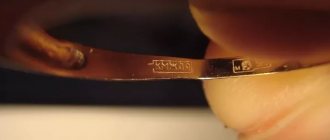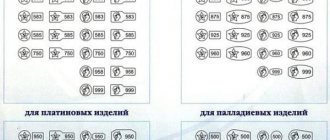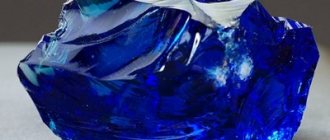If you are planning to buy gold jewelry in foreign online stores, then the first thing you should pay attention to is the number of carats. What do carats mean?
The number of carats indicates how many parts of the precious metal the product consists of, with a maximum of 24.
For example, in a 14-karat bracelet, the alloy consists of 14 parts of pure gold out of a possible 24, and the remaining 10 parts include other metals: copper, nickel or zinc.
Thus, a 22 karat gold chain will contain 22 parts pure gold and only 2 parts other metals.
The seal and its meaning.
Carats are most often indicated on gold jewelry by a number with the addition of a name indicated by the symbols: K, k, ct, CT, or CT.
For example, a ring “10 ct” and “10 karat” mean the same thing - the product contains 10 karats of gold.
Instead of carats, you sometimes see purity numbers imprinted on jewelry as percentages or parts per thousand. For example, the stamp "999" (or ".999") means that the alloy is 99.9% pure gold and this corresponds to 24K.
Sometimes, you may see the letter "P" printed next to the carat number. For example, the marking “18 KR” means that the gold content of the product is guaranteed to be at least 18 carats.
If you have already purchased a product in a foreign online store or auction and there are no carat marks on it, then if you wish, you can check it for purity.
To do this, you can contact jewelers.
A large number of specialists provide such services for an additional fee.
Typically, they determine the purity of a gold item using acid to determine the exact number of carats.
Purity of gold in samples and carats - which is more accurate and more convenient?
There are many tables and even online calculators on the Internet for converting carats to hallmarks and hallmarks to carats. However, there are even more people in the world whose favorite phrases sound something like this: “I want to do it myself” or “I want to understand.” If you are one of them, then good luck. Very soon, we will be surprised to discover how easy and simple it is to convert carats into samples and vice versa - samples into carats on our own, without any access to the Internet and without anyone’s help.
The best example of an investment gold coin of 917 purity (22 carats) is perhaps the most popular and most famous gold investment coin in the world, the Krugerrand, minted in South Africa, with a total weight of almost 34 grams. The Gold Krugerrand, by the way, is the first gold bullion coin in the world.
In 2021, it is exactly 50 years since the first minting of the gold Krugerrand investment coin. In honor of this, the Krugerrand commemorative coins were minted, with the secret "50 years of minting" mark added to the traditionally unchanged coin design. These coins are in high demand among investors and are still represented in the KDG Gold coin assortment.
The secret "50 years of minting" badge on the 2021 Gold Krugerrand commemorative coin. (Presented by KDG Gold).
The pure gold content of this coin is 1 troy ounce (31.1 grams).
If we take the total weight of the Krugerrand as conventional 24 parts, then dividing 34 grams into 24 conventional parts and multiplying the result by 22 - (by the declared purity of the coin in carats), then we will get the same 31.1 grams of pure gold as an answer . Because out of 24 conventionally taken parts of the alloy in a coin, 22 parts are pure gold. Hence the statement that the purity of the gold in this coin is 22 carats. The extra decimal places in this calculation are due to the rounding of the total weight of the Krugerrand to the full 34 grams.
It is also true that if out of the conventionally taken 24 parts of the alloy, 18 parts are pure gold, and the remaining 6 parts are impurities or alloys, then this means that we are dealing with a product of 18 carat purity. Impurities in gold are everything that ended up in the alloy by the will of nature or as a result of technological errors. Ligature, in contrast to impurities, is something that was added to the composition of the alloy with gold on purpose. A ligature is added to an alloy to give gold a specific shade or a higher degree of hardness.
To determine the purity of gold, we use the metric system. In our metric and much more accurate system, we divide the alloy into conventional 1000 parts. If out of the conventional 1000 parts of the alloy, 999 parts are pure gold, then we are dealing with a product of 999 fineness.
In the USA, Britain and many other countries, the karat system is used to determine and indicate the purity of gold. The maximum possible purity of gold in this system is 24 carats, which corresponds, in our understanding, to gold with a purity of 999 purity.
Why is the metric system more accurate than the karat system for determining the purity of gold? Firstly, because if we divide an imaginary watermelon into conditional 1000 parts, then, if we wish, we can collect exactly 637 or 835 parts from these 1000 parts. That is, in the metric system of hallmarks, we can easily create a gold product of a non-standard 637 standard and most accurately express the purity of gold in this product - the content of 637 or 835 parts of pure gold in an alloy consisting of 1000 parts. In the karate system, it is simply impossible to do this as accurately and without any error. Because if an imaginary watermelon is cut not into 1000 small parts, but into 24 large parts, then we will no longer be able to be so precise when operating with these larger parts, in order to create an alloy with 637 or 835 parts of gold. Unfortunately, carats cannot be fractional. You cannot say, “This piece has a clarity of 21.4 carats or 21.6 carats.” It doesn't happen that way. We can only say that the product has a purity of 21 carats. Or 22 carats.
This means that 24 carat purity includes gold with a purity ranging from 999 fineness to 980 fineness, or more precisely up to 979.17. Anything below the purity turns out to be 23 carat gold. Gold with a purity of 23 carats, due to the error and lack of fractionality in the karat system, also has its own range of gold purity, if we consider this purity in the usual metric system of samples.
Consequently, the widespread misconception that 24 karat gold is exclusively .999 gold and no lower remains nothing more than a common misconception. The LBMA standards, which regulate the purity of gold in bank bars as 24 carats, but not lower than 995, are clear confirmation of this.
Now, enough talk, let's create for ourselves a simple and easy mechanism for converting from samples to carats and from carats to samples. To do this, we write down 4 values in the form of a magic rectangle:
1000 – Sample 24 – Carat
- In the first line of this rectangle, we wrote down that the metric system is a sample system. And that in the metric system of samples, there are conditionally 1000 parts of gold and this is the highest possible purity of gold in our metric system.
— In the second line of this rectangle, we wrote down that in the carat system, the unit of measurement is the carat. And that in this system, conventionally, there are 24 parts of gold and this is the highest possible purity of gold, in a carat system that is alien and incomprehensible to us.
Now, in order to find out any value we need of any value in this quadrilateral we created, we just need to substitute in the right place the value we know in samples or carats. And then, multiply two quantities known to us located diagonally and the resulting result, divide by the last numerical value known to us, which remains uninvolved in our calculations and is located in any of the four corners.
For example, we need to find out what purity gold is of 14 karat purity. Since the sample is unknown to us, and we are just going to find out it, instead of the sample we are looking for, we leave the word “Sample” in our rectangle, unchanged. After which, we drive into our rectangle the value we know, expressed in carats -14 carats:
1000 – Sample 24 – 14 Carat
Now we multiply by each other, two numbers known to us, located opposite each other diagonally: 1000 * 14 = 14000 And divide the resulting result by the last value known to us and remaining unused in our calculations, the value “24”: 14000: 24 = 583 This means that gold with a purity of 14 karats is gold with a purity of 583 purity.
After which, our record took on a form in which there are no words, without numerical values assigned to them, that is, without quantities unknown to us, expressed in samples or carats:
1000 – 583 Sample 24 – 14 Carat
In this completed rectangle, already without quantities unknown to us, we see the correspondence of the purity of gold in the columns: The purity of gold with a purity of 1000 corresponds to the purity of 24 carats indicated below. And the purity of gold with purity 583 corresponds to the purity of 14 carat gold indicated below.
In the same way, we can find out the opposite - what purity in the cards will be in gold, for example 375. To do this, we substitute the sample value known to us - “375” into the first line. And instead of the unknown value in carats, we again simply leave in our famous rectangle, our no less famous word “Carat”:
1000 - 375 Sample 24 - Carat
Next, we again multiply two numbers known to us located diagonally opposite each other, after which we divide the result by the last numerical value known to us and not yet used by us, in our rectangle:
(375*24):1000=9
This means that 375-carat gold is 9-carat gold.
In our magic rectangle there are again no quantities unknown to us:
1000 – 375 Sample 24 – 9 Carat
This simple but effective method of converting samples into carats and carats into samples virtually eliminates the possibility of error. Because it is impossible to multiply or divide by words that do not have any numerical values. This means that you will not be mistaken, even thinking about something else, at the time of calculations.
If the results of our calculations turned out to be not equal to 9, but for example a fractional value of 9.55, then we would be forced to round and say that we are dealing with a product with a purity of 10 carats. Because, as we said earlier, carats do not come in whole or fractional quantities.
As you can see, everything with these hallmark carats and carato hallmarks is not so difficult - from the category of “It’s not the Gods who burn the pots.” And the ability to freely transfer the purity of gold from any carat to any standard and back will give you a significant amount of solidity, mystery and charm in any company.
Share
- 1
Share
Carat standards.
The most popular carat numbers for gold jewelry are 10, 14, 18, 20 and 22 carats. (It's rare to see 24K jewelry because pure gold is too soft.)
It is important to remember that jewelry with a purity of less than 10 carats is not technically considered gold in the United States. Keep in mind that unless your gold jewelry is about (as in "14 kiloponds"), the exact number of carats may vary slightly from what is stated on the stamp.
In the US, the tolerance is +/- 0.5 carats. This means that your 14 karat gold piece may actually be 13.5 karats.
How are samples determined?
First you need to analyze the quality of the precious metal. It indicates the presence of gold in the alloy. And with the help of quantitative analysis, its purity is already determined. The more gold there is in the alloy and the higher its purity, the higher the price of gold will be.
Samples of precious metals and their alloys are determined in many ways.
These include:
- The touchstone method is the most common method. It is carried out by comparison with a certain standard of scratches from the alloy under study, which are applied to a stone with a silicon base. In this case, an acid solution is used to analyze the reaction.
- The spectral analysis method is the most accurate, but it uses special devices - spectrometers, which transmit X-rays through the tested material and determine the required indicators.
- Alloy conduction method of electricity.
- Method of melting the material under study in a muffle furnace. This is a device with which the material is heated to the desired temperature. This method is based on the difference in melting temperatures of various metals and is mainly used for smelting pure metal from an alloy.
What is the difference between large and small carat values?
Generally, the lower the karat and less pure gold metal in your jewelry, the heavier and more durable it will be.
The disadvantage is that the less pure gold there is in the alloy, the less similar it will be to gold.
In addition, the smaller the carat, the more nickel the alloy contains in its composition.
For people who are allergic to nickel, low karat gold jewelry may cause breakouts and skin irritation.
Higher carat values, on the other hand, look better because... contain more gold.
But pure gold is a rather soft metal, so products made from this alloy are more easily scratched.
The most popular are 14 and 18 carat jewelry, as these carat levels provide a good balance of durability, quality and price without causing allergic reactions.
How to calculate?
It is known that the hallmark indicates the number of grams of gold or other precious metal in the alloy, while the carat is a unit of measurement of the purity of gold, it demonstrates the content of the precious part in the product.
10k gold ring
There are the following standard markings of aurum, expressed in carats: 24, 18, 14, 12, 9, 8. In this scale, 24 is equal to 999 fineness - an indicator characteristic of pure gold. Converting units of measurement of metal purity into grams is not difficult, the main thing is to know the formula that allows you to do this.
The formula looks like this: 24/1000 = X/Y. In this case, X is the carat indicator, and Y is the fineness. So, if we need to get ahead of the marking, knowing the number of units (10), we need to perform several mathematical operations using the following formula:
Y = 1000*10/24= 417.
In fact, 417 markings are not found in Russia and the CIS countries, although such a metal alloy is manufactured abroad. What properties can such raw materials have? First of all, the alloy consists of only 41.7% of the precious component, while the alloy accounts for 58.3% of the composition. Its properties will be similar to that of the metal marked 375.
The features of low-quality aurum include good workability due to the high content of copper - a strong and wear-resistant metal. But do not forget that 417 gold is characterized by a large amount of alloy, the components of which (the same copper) are prone to rapid oxidation. This leads to damage to the appearance of products made from low-quality metal. The alloy, which contains less gold than ligatures, is widely used in the manufacture of settings for semi-precious and decorative stones, jewelry with semi-precious stones and other accessories. Metal marked 417 is popular in countries such as Turkey, UK, China, Thailand, etc.
Rings with different alloys
If jewelry made from alloy 417 comes into Russia from abroad, then they are all controlled by the Assay Office of the Russian Federation. After checking the authenticity of the products, they are stamped with the marking 375 (standard).
How to check the actual purity of a gold item?
Many people are interested in how to test gold jewelry for purity. But how clean will the jewelry really be? And how can you find out the actual gold content of a piece of jewelry?
Let's take a look at what works in gold purity testing and what doesn't.
What is pure gold?
It is generally accepted that gold that does not mix with other metals is pure. 24 karat purity is the highest purity possible and corresponds to approximately 99.9% gold content. Pure gold is very soft and malleable, and has an intense yellow color.
Due to its softness, it is rarely used for jewelry. 24k gold items bend very easily, so pure gold is not a good choice for items that will be worn as jewelry.
Carat sample system
The gold hallmark system is closely interconnected with the karat system, as demonstrated by the formula described above. So, 18 carats corresponds to the marking 750, 14 - 585, etc.
Many people interested in precious metals may wonder about the existence of an alloy with a value of 22 units. If we convert this figure into grams using the formula 1000 * 22/24, we can get the number 916, which corresponds to 22 carats. This alloy has the following features:
- The cost of a gram of such raw materials in Russia ranges from 1900 to 2100 rubles.
- The alloy has a rich yellow color, since one kilogram of it contains at least 916 grams of aurum and only 84 grams of alloy - impurities represented by silver and copper.
- Abroad, in particular in the East and in some European countries, you can easily find jewelry with this marking for sale in jewelry stores. In Russia and the CIS countries, such raw materials are practically not used in the production of jewelry. Any aurum marked 900 or more is used as a raw material for the manufacture of some orthodontic prostheses, parts in the field of microelectronics, etc.
If a person decides to purchase jewelry abroad, then he must not only understand how the units of value of the metal relate to each other. When buying jewelry abroad, preference should be given to trusted jewelry stores that have an impeccable reputation among buyers. However, this rule also applies if the buyer gives preference to domestic jewelry.
What do the marks 750, 585 and 417 mean on gold jewelry?
What is gold purity?
If you have gold jewelry, you may notice that it has a small number stamped on it. Experienced gold buyers know exactly what these numbers mean, and they use this information when determining how much they will pay for any piece of jewelry.
Here's a quick guide to these gold tags.










